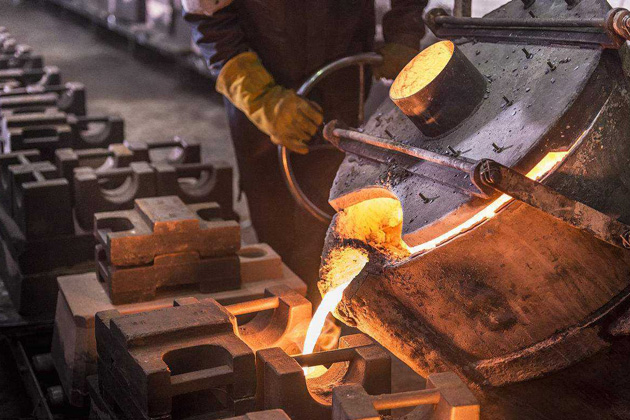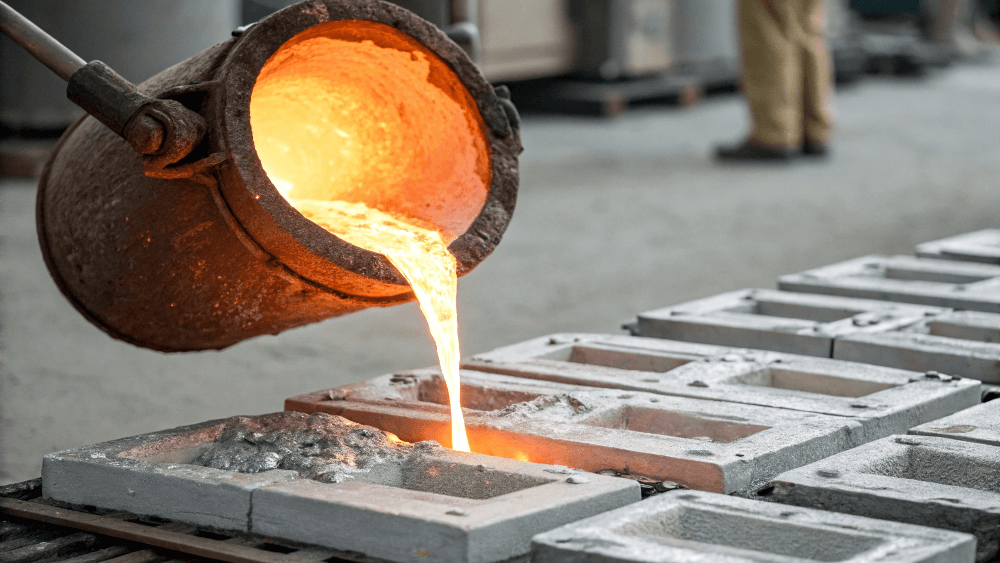Exactly How Aluminum Foundry Adds to Advancements in Aerospace Design
Aluminum factories are important to developments in aerospace design. They create lightweight, high-strength elements that are vital for modern-day airplane. Via innovative spreading methods, these shops develop complex geometries that enhance structural stability. Additionally, the growth of exceptional Aluminum alloys sustains the industry's concentrate on gas efficiency and sustainability. Nevertheless, challenges remain in the production process. Recognizing these elements reveals the profound effect of Aluminum on aeronautics's future.
The Relevance of Lightweight Products in Aerospace Design
As the aerospace sector proceeds to develop, the value of lightweight materials ends up being progressively evident. The demand for effectiveness and sustainability drives designers to prioritize making use of materials that lower total weight without compromising structural honesty. Light-weight materials, specifically Aluminum, play a vital role in improving gas effectiveness, improving payload capacity, and increasing the overall performance of aircraft.
The combination of these materials enables for innovative designs, making it possible for manufacturers to create even more aerodynamic shapes that can stand up to extreme problems. The decrease in weight not only reduces functional costs however likewise adds to a reduced environmental impact, lining up with international initiatives toward sustainability in air travel.
Advanced Spreading Techniques in Aluminum Foundries
Advanced casting methods in Aluminum foundries play an essential duty in aerospace design by making it possible for the manufacturing of lightweight and accurate elements. Technologies in mold and mildew design and accuracy casting processes are vital in attaining excellent performance and architectural honesty. Additionally, the growth of lightweight alloys enhances the overall efficiency and performance of aerospace applications.
Cutting-edge Mold And Mildew Design
Innovative mold and mildew layout plays a crucial role in the effectiveness and performance of Aluminum factories, particularly within the aerospace industry. By leveraging advanced products and methods, modern mold and mildews can be engineered to endure heats and stress, making certain peak efficiency throughout the casting process. These designs often include complicated geometries that permit for the production of light-weight yet structurally audio components, essential for aerospace applications. Additionally, the usage of computer-aided design (CAD) software program helps with specific modeling, allowing foundries to refine and replicate mold and mildew styles prior to physical production starts. This not just enhances the top quality of cast parts however likewise lowers waste and lead times, resulting in substantial cost savings. On the whole, cutting-edge mold layout is a keystone of development in Aluminum Foundry innovation for aerospace design.
Accuracy Casting Procedures
The performance of innovative mold layouts perfectly integrates with accuracy spreading processes, which are vital for producing top quality Aluminum parts in aerospace design. These procedures, consisting of sand casting, die spreading, and financial investment spreading, assure the creation of intricate geometries with limited resistances. Advanced methods like vacuum casting and pressure die casting enhance the integrity and surface coating of the end products. Precision casting reduces material waste while taking full advantage of the mechanical homes of Aluminum, vital for aerospace applications. In enhancement, employing real-time monitoring and advanced simulation devices during the spreading process allows for instant adjustments, leading to enhanced high quality control. Collectively, these accuracy casting procedures placement Aluminum foundries at the forefront of aerospace innovation, sustaining the sector's need for dependability and performance.
Light-weight Alloy Advancement
As aerospace engineers look for to enhance fuel efficiency and performance, light-weight alloy growth ends up being an essential focus in Aluminum shops. These shops employ innovative spreading methods to create alloys that give premium strength-to-weight ratios. Advancements in alloy make-up, including the unification of elements like lithium and magnesium, make it possible for the manufacturing of materials that endure extreme problems while reducing total aircraft weight. Strategies such as die casting and financial investment casting assist in the accuracy production of complex forms, which are important for aerospace applications. Furthermore, ongoing research study intends to optimize these alloys for boosted mechanical buildings and enhanced resilience. By prioritizing lightweight alloy growth, Aluminum foundries considerably contribute to the advancement of aerospace engineering, leading the means for much more effective and lasting aircraft styles.

Enhancing Architectural Honesty Via Aluminum Components
Aluminum elements use significant advantages in enhancing structural stability within aerospace design. Their light-weight nature contributes to total effectiveness while keeping toughness, which is necessary for airplane efficiency. Furthermore, the anxiety resistance residential properties of Aluminum assistance ensure the durability and dependability of aerospace structures under numerous functional problems.
Light-weight Material Benefits
While conventional materials typically jeopardize weight for strength, utilizing Aluminum components in aerospace engineering supplies significant benefits in architectural honesty. Aluminum's light-weight nature adds to general layout performance, enabling even more streamlined aircraft that eat much less gas, consequently boosting sustainability. The product's exceptional strength-to-weight ratio assurances that parts preserve toughness without adding unneeded mass. This quality cultivates enhanced performance and dexterity in flight, as well as enhanced payload capacities. In addition, Aluminum's resistance to rust prolongs the life-span of aerospace structures, lowering maintenance prices and improving safety and security. As suppliers significantly take on Aluminum alloys, the aerospace market experiences a transformative change towards more reliable and effective engineering solutions that prioritize both efficiency and environmental obligation.
Stress Resistance Residences
Different materials have unique homes, Aluminum's extraordinary stress and anxiety resistance stands out as an important aspect in boosting the architectural integrity of aerospace elements. This resistance her latest blog plays an essential role in ensuring that airplane can withstand numerous functional stresses, consisting of exhaustion, impact, and environmental problems. Aluminum alloys, particularly engineered for aerospace applications, exhibit high tensile strength while preserving lightweight qualities, enabling designers to develop a lot more reliable frameworks - Aluminum Foundry. In addition, the capability of Aluminum to withstand cyclic loading without considerable deformation adds to the long life and integrity of aerospace parts. As innovations continue in Aluminum Foundry methods, the development of stress-resistant Aluminum parts assures more renovations in efficiency, safety, and performance throughout the aerospace industry, strengthening Aluminum's duty as a favored product in contemporary engineering
Fuel Efficiency Improvements Driven by Aluminum Innovations
As the aerospace industry looks for to enhance gas effectiveness, cutting-edge uses Aluminum have emerged as an essential solution. Aluminum's light-weight nature especially minimizes aircraft weight, permitting reduced gas consumption during trip. This reduction in weight is vital, as even tiny declines can bring about substantial improvements in total gas economic situation.
Advanced Aluminum alloys, developed for enhanced strength and sturdiness, enable manufacturers to produce components that keep structural stability while decreasing mass - Aluminum Foundry. Furthermore, the integration of Aluminum in airframes and engine parts assists in improved the rules of aerodynamics, adding to decreased drag and increased efficiency
The fostering of Aluminum in aerospace not only satisfies the demand for fuel-efficient style but likewise lines up with governing pressures for reduced emissions. As these innovations proceed to evolve, they play a substantial role in setting brand-new criteria for gas efficiency, guaranteeing that the aerospace sector can fulfill growing ecological and financial difficulties.

The Duty of Aluminum in Sustainable Air Travel Practices
The raising focus on lasting aeronautics techniques has actually positioned Aluminum as a vital product in the quest for greener aircraft design. Understood for its lightweight buildings, Aluminum significantly minimizes aircraft weight, leading to lower fuel usage and discharges. Its recyclability additionally enhances its sustainability profile, as Aluminum can be reused forever without loss of high quality. This particular sustains a round economy within the aeronautics market, minimizing waste and resource exhaustion.
Additionally, improvements in Aluminum alloys have actually enhanced their stamina and rust resistance, enabling longer service life and decreased maintenance needs. These technologies promote the advancement of much more effective aircraft frameworks, adding to overall sustainability initiatives. Furthermore, Aluminum's thermal conductivity plays an important duty in energy-efficient styles, enhancing systems such as warm exchangers. Collectively, these features underscore Aluminum's essential duty ahead of time lasting aviation, aligning with international campaigns aimed at lowering the ecological impact of flight.
Difficulties Dealt With by Aluminum Foundries in Aerospace Manufacturing
While Aluminum shops play a necessary function in aerospace manufacturing, they face substantial obstacles that can affect manufacturing efficiency and quality. One significant challenge is the rigorous quality control criteria required in the aerospace sector. Any kind of flaw can compromise safety and security and efficiency, requiring strenuous inspection processes that prolong production timelines. Additionally, foundries typically emulate rising and fall basic material expenses, which can impact rates and earnings. The intricacy of Aluminum alloys made use of in aerospace applications more complicates the manufacturing process, as specific formulations are critical for accomplishing wanted mechanical homes. Moreover, knowledgeable labor shortages impede the capacity to keep high-quality production degrees. Ultimately, environmental policies impose restrictions on exhausts and waste administration, needing shops to purchase lasting practices, which can be cost-prohibitive. These elements jointly develop a landscape where Aluminum factories should continuously adapt to fulfill the evolving demands of aerospace manufacturing while making sure security and compliance.
Future Patterns in Aluminum Applications for Aerospace Engineering
With advancements in innovation and enhancing demands for efficiency, the future of Aluminum applications in aerospace engineering is poised for significant transformation. The combination of innovative Aluminum alloys and composites is anticipated to improve strength-to-weight ratios, resulting in even more fuel-efficient aircraft designs. Furthermore, developments in additive manufacturing strategies will certainly permit the manufacturing of complex Aluminum structures that were formerly difficult, maximizing efficiency and decreasing waste.

Lasting practices will play a crucial function, with an expanding emphasis on recycling Aluminum to decrease environmental effect. The aerospace field is likely to accept smarter making procedures, such as automation and expert system, guaranteeing better and accuracy in Aluminum elements. In addition, partnerships in between Aluminum factories and aerospace companies will certainly foster r & d, leading the way for new try this applications that satisfy the rigorous demands of modern-day aerospace design - Aluminum Foundry. On the whole, the future looks assuring for Aluminum's duty in shaping the skies
Regularly Asked Inquiries
What Are the Ecological Influences of Aluminum Manufacturing in Aerospace?
The ecological influences of Aluminum manufacturing in aerospace include considerable energy intake, greenhouse gas emissions, and habitat disruption. Additionally, mining processes can bring about soil destruction and water contamination, elevating concerns concerning sustainability and eco-friendly balance.
How Does Aluminum Compare to Various Other Products in Aerospace Applications?
Aluminum provides a distinct combination of light-weight buildings, deterioration resistance, and cost-effectiveness compared to other materials. Its high strength-to-weight proportion makes it especially beneficial for aerospace applications, enhancing gas effectiveness and general performance in airplane design.
What Qualifications Do Aluminum Foundry Workers Requirement for Aerospace Projects?
Aluminum Foundry employees need specialized training in metallurgy and spreading methods, along with expertise of aerospace sector requirements. Accreditations in quality assurance and safety methods are likewise crucial to ensure compliance with rigid aerospace job requirements.
Are There Any Type Of Safety And Security Interest In Making Use Of Aluminum in Aerospace Engineering?
Safety issues see this here regarding Aluminum in aerospace design include sensitivity to anxiety, exhaustion, and corrosion cracks. Appropriate therapy and alloy option are essential to minimize these threats, making certain architectural honesty and total security in aerospace applications.
Exactly How Does Aluminum Recycling Advantage the Aerospace Market?
Aluminum recycling substantially benefits the aerospace industry by lowering product expenses, reducing ecological influence, and preserving energy. This lasting method boosts the industry's efficiency while advertising using light-weight, high-performance components in aircraft manufacturing.
Advanced spreading strategies in Aluminum factories play an essential function in aerospace engineering by making it possible for the production of exact and lightweight components. Cutting-edge mold layout plays a crucial function in the effectiveness and efficiency of Aluminum shops, particularly within the aerospace industry. As aerospace engineers seek to enhance fuel performance and performance, lightweight alloy growth comes to be an important focus in Aluminum shops. Aluminum alloys, specifically engineered for aerospace applications, display high tensile stamina while maintaining lightweight characteristics, making it possible for engineers to make a lot more reliable structures. Partnerships between Aluminum foundries and aerospace companies will certainly cultivate research study and growth, paving the way for new applications that fulfill the strict needs of modern aerospace engineering.